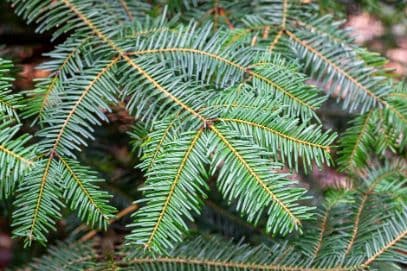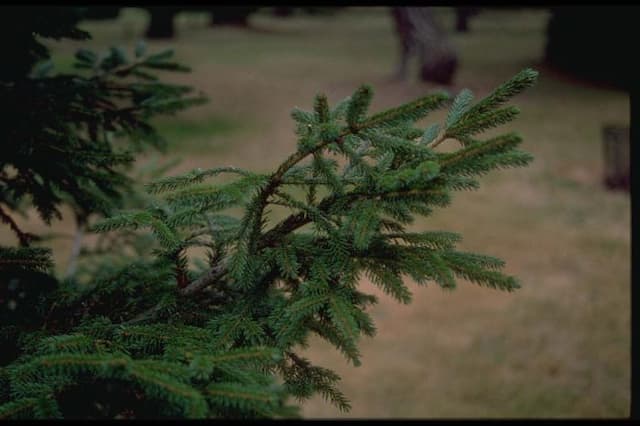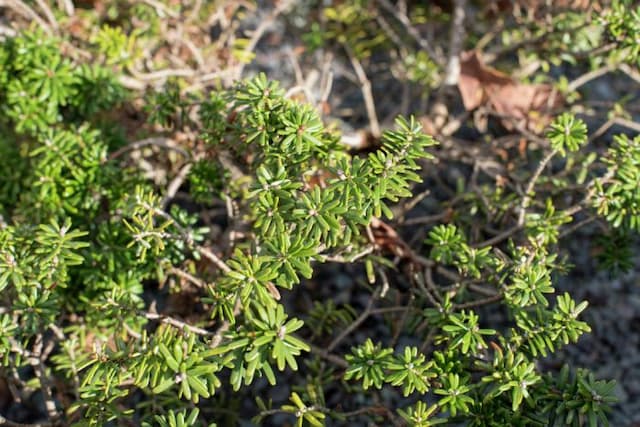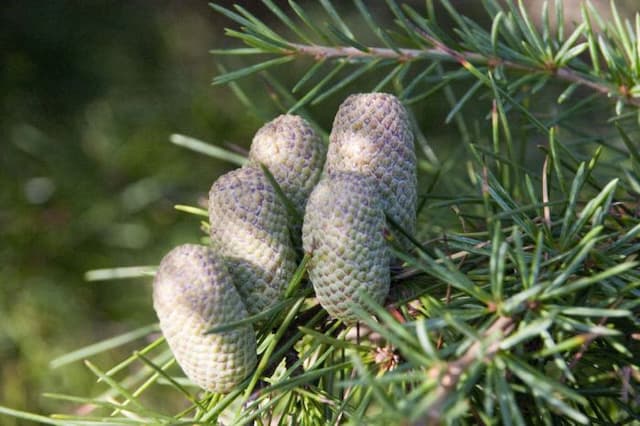Picea glauca Perfecta = 'Hb07' (PBR)

ABOUT
The Picea glauca Perfecta, commonly known as the White Spruce 'Perfecta', is characterized by its dense, cone-shaped growth habit. It presents a lush display of needles that have a delicate bluish-green hue, which contributes to its common name and distinctive appearance. The needles are short and stiff, arranged spirally on the branches, creating a full and refined texture that enhances its appeal in ornamental settings. The branches of this White Spruce 'Perfecta' start relatively low on the trunk and ascend upwards, tightly packed to give it a neat and compact appearance. As an evergreen, it maintains its color and foliage year-round, offering a consistent visual interest through all seasons. The tree has a natural, symmetrical form that requires minimal pruning to maintain its polished look. During the early years, the growth of this White Spruce cultivar is relatively slow, which contributes to its well-maintained shape. Over the years, it develops a sturdy, central leader that supports the overall structure of the tree. As time passes, the tree may produce cones that further accentuate its aesthetic value. These cones start out pale and eventually mature to a light brown, hanging elegantly from the branches and providing contrast against the bluish-green needles. The White Spruce 'Perfecta' is valuable for its ornamental qualities and is often selected for use in landscaping, gardens, and as a focal point in various outdoor spaces. Its resilience and attractive appearance make it a favored choice among gardeners and landscape architects.
About this plant
 Names
NamesFamily
Pinaceae.
Synonyms
White Spruce, Canadian Spruce, Skunk Spruce, Cat Spruce, Black Hills Spruce.
Common names
Picea glauca Perfecta = 'Hb07' (PBR).
 Toxicity
ToxicityTo humans
The plant in question is commonly known as White Spruce. White Spruce is not typically considered toxic to humans. Ingesting parts of the plant are not commonly associated with poisoning or severe reactions. However, as with ingesting any non-food plant material, individuals may experience mild stomach upset or discomfort. If any significant symptoms do occur after ingestion, medical advice should be sought.
To pets
White Spruce is not known to be toxic to pets. It is not normally associated with poisoning if pets ingest parts of the plant. Nonetheless, some animals may experience mild gastrointestinal upset if they consume parts of the white spruce. Keeping an eye on your pet after ingestion and consulting with a veterinarian if any concerning symptoms appear is advisable.
 Characteristics
CharacteristicsLife cycle
Perennials
Foliage type
Evergreen
Color of leaves
Green
Height
6-8 feet (1.8-2.4 meters)
Spread
3-4 feet (0.9-1.2 meters)
Plant type
Tree
Hardiness zones
2-6
Native area
North America
Benefits
 General Benefits
General Benefits- Ornamental Appeal: Picea glauca 'Perfecta', commonly known as White Spruce, has a distinctive conical shape and dense, compact foliage that adds aesthetic value to landscapes.
- Low Maintenance: White Spruce requires minimal care once established, making it a convenient choice for both novice and experienced gardeners.
- Cold Hardy: This species is extremely tolerant of cold temperatures, making it suitable for northern climates and high-altitude areas.
- Windbreak and Privacy: Its dense growth habit makes White Spruce excellent for use as a windbreak or natural privacy screen.
- Drought Tolerance: Once established, it can withstand periods of limited moisture, making it suitable for xeriscaping in suitable climates.
- Adaptability: It adapts well to a variety of soil types, though it prefers well-drained, acidic soils.
- Wildlife Habitat: The dense foliage provides shelter for birds and small mammals, while the cones offer a food source for wildlife.
- Long-Lived: White Spruce is known for its longevity, often living for many decades and providing a stable feature in the landscape.
 Medical Properties
Medical PropertiesThis plant is not used for medical purposes.
 Air-purifying Qualities
Air-purifying QualitiesThis plant is not specifically known for air purifying qualities.
 Other Uses
Other Uses- The White Spruce's dense foliage can provide a sound barrier, making it useful for planting along roads or highways to reduce noise pollution.
- Because of its symmetrical shape and evergreen nature, the White Spruce can be used in theme parks or attractions to create a visually appealing landscape year-round.
- Its wood pulp is suitable for making paper, particularly for its long fibers which contribute to the strength of paper products.
- Crafters may use the small branches and twigs of the White Spruce for wreath-making, especially during the holiday season.
- The tree's resin can be used in the production of varnishes and adhesives.
- White Spruce can be planted in outdoor educational environments to study plant growth, ecology, and adaptation in a changing climate.
- It can serve as a natural habitat for wildlife, providing shelter and food for a variety of birds and small mammals.
- The White Spruce is often used for soil stabilization and reforestation projects because of its hardiness and adaptability.
- Due to its aesthetic and evergreen characteristics, the White Spruce is sometimes used in film and photography as a scenic background element.
- The White Spruce can be used as a natural Christmas tree in landscaping to bring a festive atmosphere during the holiday season.
Interesting Facts
 Feng Shui
Feng ShuiThe White Spruce is not used in Feng Shui practice.
 Zodiac Sign Compitability
Zodiac Sign CompitabilityThe White Spruce is not used in astrology practice.
 Plant Symbolism
Plant Symbolism- Resilience and Endurance: As a type of white spruce, Picea glauca Perfecta is known for its ability to survive in harsh conditions, symbolizing the human ability to endure challenging situations and persevere.
- Purity and Clarity: The species name "glauca" refers to the blue-green color of the needles, often associated with clarity and purity of thought or intention.
- Growth and Stability: Spruces are often symbolic of growth because they are fast-growing trees. Their strong root systems also represent stability and grounding.
- Protection: Spruce trees have historically been used to make remedies for various ailments, offering a symbol of protection and healing.
- Eternal Life: Evergreen plants like Picea glauca Perfecta retain their foliage all year round, which is why they often symbolize immortality and eternal life.
 Water
WaterThe White Spruce 'Conica' prefers consistent moisture but does not do well in overly wet conditions. Water the plant deeply, ensuring that the soil is moist but not soggy, about once a week during dry conditions. It may require less frequent watering during periods of normal rainfall. Approximate water needs could be around 1 to 1.5 gallons per week, depending on weather conditions and soil moisture levels. Always check the soil moisture before watering to avoid overwatering.
 Light
LightWhite Spruces 'Conica' thrive in full sun to partial shade. They perform best when they receive at least 4-6 hours of direct sunlight per day. A spot that provides morning sunlight with some afternoon protection is ideal to prevent scorching during the peak summer months.
 Temperature
TemperatureWhite Spruces 'Conica' are hardy plants that can withstand cold temperatures, typically surviving in temperatures as low as -40°F. They prefer cooler climates and can struggle with heat if temperatures frequently exceed 90°F. The optimal temperature range for this spruce is between 30°F and 70°F.
 Pruning
PruningThe White Spruce 'Conica' typically requires minimal pruning, with the best time being the late winter or early spring before new growth starts. Pruning can help maintain its desired shape and remove any damaged or diseased branches. Periodic thinning of the branches may also improve air circulation. Pruning should be done sparingly, as heavy cutting back can damage the plant.
 Cleaning
CleaningNot needed
 Soil
SoilWhite Spruce requires a well-drained, acidic to neutral soil mix with a pH of 6.0 to 7.0. A combination of peat, loam, and sand in equal parts works well to ensure drainage and support its growth.
 Repotting
RepottingWhite Spruce, a slow-growing conifer, doesn't require frequent repotting. Repot young trees every 3-4 years, and mature trees can be repotted less frequently or as needed.
 Humidity & Misting
Humidity & MistingWhite Spruce prefers a moderate humidity level, typical of outdoor environments. It is adaptable and does not require specific humidity adjustments when planted in its natural outdoor habitat.
 Suitable locations
Suitable locationsIndoor
Not ideal for indoor growth; requires sunlight, seasonal change.
Outdoor
Plant in sun, water regularly, protect from strong winds.
Hardiness zone
2-6 USDA.
 Life cycle
Life cyclePicea glauca 'Perfecta', commonly known as White Spruce 'Perfecta', begins its life as a seed, typically germinating in spring in moist, cool conditions. Upon germination, it develops into a seedling, establishing a root system and beginning to grow upwards. As a sapling, it slowly matures over several years, developing a woody stem and characteristic conical shape, while being more tolerant of environmental variances like drought and cold. It reaches maturity in its growth when it starts to produce cones after 10-15 years or more, depending on local conditions. Reproduction occurs when mature cones release seeds, which are then spread, often by wind or animals, to create new plants. The White Spruce 'Perfecta' can live for well over a century, continually growing in height and girth while playing a role in its ecosystem until eventual senescence sets in, leading to its decline and eventual death.
 Propogation
PropogationPropogation time
Late winter to early spring
Propogation: Picea glauca, commonly known as White Spruce, is typically propagated through seeds, but the Perfecta = 'Hb07' (PBR) being a patented variety, may have restrictions on propagation methods and is often propagated vegetatively to maintain the specific characteristics of the cultivar. The most popular method of propagation for this type of White Spruce is through semi-hardwood cuttings. This process involves taking a cutting from a healthy parent plant during the late summer when the new growth has begun to mature and harden. The cuttings, usually about 4 to 6 inches (10 to 15 centimeters) long, are treated with a rooting hormone to enhance root development and then placed in a well-draining rooting medium. The environment needs to be kept humid, which is often achieved by placing a plastic cover over the cuttings, and a consistent temperature is maintained to encourage rooting. After several weeks to months, the cuttings should develop roots and can be transplanted into individual containers or directly into the ground.









